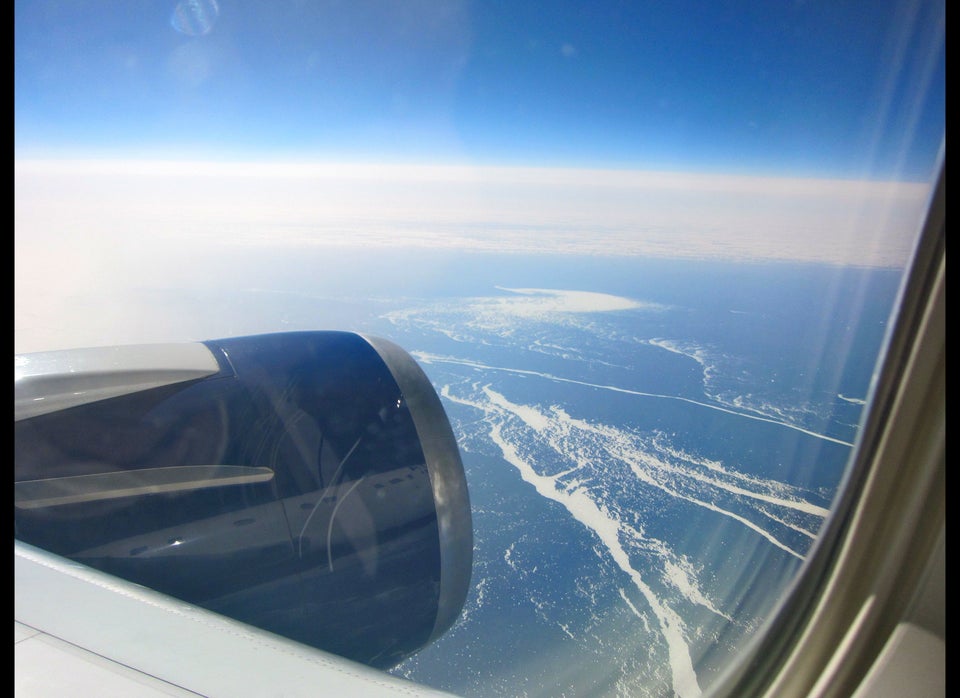Travel is supposed to spread out a fandex of beautiful destinations. You arrive somewhere far off, you do your best to take in the sights there and soon you are ready to flip to the next card. The airplane flights that do the grunt work of your trip, that allow you to get from place to place, are a sort of forgettable magic that, if you are like me, you do not record in your diary or photograph.
When friends say, "How was your flight?," they are asking about its smoothness, its on-time-ness, about the discomforts of being squashed into a washing-machine sized space for hours at a time. Since 9/11, they'll want to know something about the security lines you've stood in, whether your razor or scissors were confiscated, whether--these days--you are afraid.
What no one ever asks about is what you might have seen up there. About any sense of adventure in rising 36,000 feet above the earth. Or about hurtling along, above mountainous white clouds, at more than half the speed of sound. It's startling that this has happened, but we have lost our sense of wonder at flight itself, at being able to launch ourselves like swallows into the air and stay up there, chasing or escaping the sun.
Maybe it's because, for many years, I was afraid to fly, but I still haven't gotten rid of the suspicion that enormous metal objects cannot, in fact, get off the ground. Every time I'm pressed back into my seat on board a 767 I believe that this will be the time gravity will say no: No matter how fast this fat carrier of people and their luggage is made to go, it must respect my rules! But somehow with all our suitcases and bottled drinks and pets in carriers we get up there, and I shake my head in disbelief.
Not long ago, I found a dog-eared travel guidebook from the late 1940s that had belonged to an uncle who was, as a matter of pride, always well-informed. After I shook the dust off and started reading bits of it, I realized that efforts, like mine, in coming to grips with flight and with the relatively new world of air travel were evident on almost every page. "Do not worry," reassures the author in the chapter on traveling by plane. "The sparks and red glow which you will see from your windows are perfectly normal phenomena of the flight. They are the exhaust from the engines. Streamers from the wing tips are electricity discharges and releases."
The guidebook is at its best when it suggests sitting in the back of the plane "because you can see the ground better from there." It takes pains to warn passengers about opening a pen since "the air pressure may cause it to spatter," and it promises that "beautiful or unusual scenic effects, such as the Aurora Borealis on the northern routes, will be noted by the pilot and called to your attention." How I wish. These days, pilots don't point out much of anything, unless you're flying over an obvious landmark like Mount Rushmore or the Grand Canyon.
As I've only recently found out, some of the most interesting travel dispatches tell you not about ancient cities, not about powdery beaches--but about views from the air. In her 1942 memoir, West With The Night, pioneering aviator Beryl Markham writes that "The rest of the world may have grown complacent...about aeroplanes flying in the night, but...ours was a young world, eager for gifts--and this was one." In the air, Markham sees everything, above and below. "Far up in the Highlands," she notices, "a storm had burst, and while the sky I flew in was clean and blue as a Dutch rooftop, the Yatta was a jungle island in a rain-born sea...In twenty minutes I saw their smoke. It was a wizened little string of smoke, sad and grey, and looking like the afterglow of a witch's exit."
Even though I can be as dulled to jet travel as the next guy, I've started trying to ignore the tight fit of coach seats and, nose to plastic, take a lesson from Markham by paying attention to the cloud--or smoke--formations I'm flying through. I'm trying to pick out the glow of far-off cities at night, the necklaces of lighted bridges, the furry texture of forests, the chess-board pattern of somebody's large farm. Even over water, I'm staring down, and finding fabric-like ripples and miniature bathtub-sized boats in the blue ocean below.
Maybe I will get tired of being a tourist of the upper air, and go back to reading the Sky-Mall magazine in my seat-pocket. Maybe I will even get used to the ease with which steel fuselages can speed along the ground and lift off. But, truth is, I'm not looking forward to that day.
I happen to be enjoying the view.
Peter Mandel is an author of picture books for kids, including his read-aloud bestseller: Jackhammer Sam (Macmillan/Roaring Brook), and his newest about zoo animals passing on a very noisy sneeze: Zoo Ah-Choooo (Holiday House).
